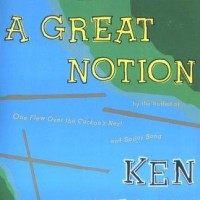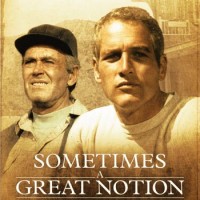Our first LiterList: Good Novels That Turned Into Pretty Good Films
One of the things you will find in the Literarea is lists. Yes, lists. Let's call them LiterLists. These LiterLists will cover a wide range of literary topics and generally be focused on things we like, although there may be the occasional list of things we hate. Each list will grow over time with periodic additions being made, some based on reader feedback. So if our LiterList gives you a LiterThought send us a LiterNote or make a LiterComment (okay, we'll stop).
In our first LiterList, we take a look at good novels that turned out to be pretty good films. After all, there are so many that have turned out badly (we're looking at you, "All The King's Men" and "The Great Gatsby"), we thought we'd hunt down some of the better ones. Each receives three ratings on a scale of one to 10 (with 10 being really good and lower numbers signifying increasing degrees of "meh"). One rating will be for the novel itself, one for the film adaptation and a final for how the two work together.
So without further ado, here's our first LiterList:
GOOD NOVELS THAT TURNED INTO PRETTY GOOD FILMS
Sometimes A Great Notion
The Book
Published in 1964, "Sometimes a Great Notion" was Ken Kesey's (pronounced KEE-zee) second novel after "One Flew Over The Cuckoo's Nest" (1962), which was an immediate success. The story is centered around the Stampers, a very stubborn family in Oregon whose logging business is fighting an ongoing battle with union loggers. The union is on strike against the regionally owned mill, while the Stamper family decides to continue to work and supply the mill, which creates friction in the community.
The pater familias is Henry who has two children from different marriages. The oldest, Hank, works for the family logging business and the youngest, Leeland, returns suddenly after 10 years in New York with his mother, Henry's ex-wife. Along with the logging side of the story, there are revelations about Hank's relationship with Leeland's mother, as well as Leeland's relationship with Hank's wife, Viv.
The family is also facing another challenge from an even more difficult adversary: Mother Nature. The river that flows past their home is widening and slowly eroding the land beneath their homestead, just like it did to all the Stamper's now-former neighbors. But the Stamper family fights on with sand bags, boards and cables. In essence, this story is about a family that will NOT give in. Incidentally, the title of the novel is taken from a line in the song "Goodnight Irene": "Sometimes I get a great notion/To jump into the river and drown."
Even though this was Kesey's second book, it almost feels as if it should have been his first. It's not unusual for a writer's first novel to be about their childhood home, presenting a fictionalized or idyllic version of their family (see: Kerouac's "The Town and The City" or Thomas Wolfe's "Look Homeward, Angel"), with their second novel being more experimental (see: Kerouac's "On The Road" and Wolfe's...Ok, Wolfe pretty much ALWAYS wrote about his family per se but you get my point). And "Great Notion" definitely has that first-novel feel with its family theme and nostalgic tone. Plus, Kesey grew up in and had a great love for the deep forests of Oregon. So it's not surprising that this affinity made its way into his work somewhere.
While "Cuckoo's Nest" was more famous, many critics consider "Great Notion" his greatest work. The style is experimental, yet more realistic than "Cuckoo's Nest". The novel itself is a sprawling story, with each character speaking in the first person (similar to Faulkner's "The Sounds and The Fury") which allows the story to be pieced together bit by bit. Each character talks directly to the reader, telling their side of the story while illustrating the fact they don't communicate well amongst themselves. And to top it off, it ends with a great flourish and a surprise or two.
LITERAREA BOOK RATING: 8
The Film
The film adaptation of "Sometimes a Great Notion" came out in 1971 with an incredible cast: Henry Fonda as the patriarch Stamper, Paul Newman as Hank, Michael Sarrazin as Leeland, Lee Remick as Viv and Richard Jaeckel as Joe Ben Stamper. It also marked Newman's second directorial effort.
In order to turn the 600+page novel into a just-under-two-hour film, significant cuts in the story had to be made, with the most noticeable being the elimination of the rising river plotline. The novel also spent a lot of time telling stories about a pack of hounds that the Stampers have (including their sad demise), which was eliminated from the film adaptation.
The film succeeds because it sticks to the two key narratives: the battle with the unions and the surprising relationships that are revealed between Newman/Sarrazin/Remick. It also succeeds because of the great cast – honestly, Fonda and Newman playing a tough, hard-headed father/son duo is enough by itself.
Some of the best scenes in the film take place when the men are working in the forests, felling trees and loading them onto trucks and skidders. The way the scenes are shot underscore the explicit danger of the job – the cameras themselves even seem to be at risk – while showcasing the natural beauty of the great forests of Oregon. The film earned two Academy Award nominations – Best Supporting Actor for Jaeckel (lost to Ben Johnson in "The Last Picture Show") and Best Original Song for "All His Children" (lost to "Theme from 'Shaft'").
As stated earlier, the novel "ends with a great flourish and a surprise or two" (bonus points for quoting myself!). The film version brings that great flourish to life in a surprising and humorous way, while kind of glossing over the "surprise or two" (double bonus points!).
LITERAREA FILM RATING: 7
OVERALL LITERAREA RATING: 8
Sure, there are portions and plotlines from the novel that have been excluded, but every film adaptation HAS to do that – unless the novel in question is 90 pages with very sparse language and very little description. The test of a good adaptation is how skillfully the editorial tools are wielded. In this case, the filmmakers have dissected the novel well, focusing on the essence of the story – a stubborn, stubborn family. The dialogue does not deviate from the text very much, which is a testament to Kesey's skills as a writer and Newman's understanding of that fact.
Coming Soon:
FEAR AND LOATHING IN LAS VEGAS
A CLOCKWORK ORANGE
THE GODFATHER


